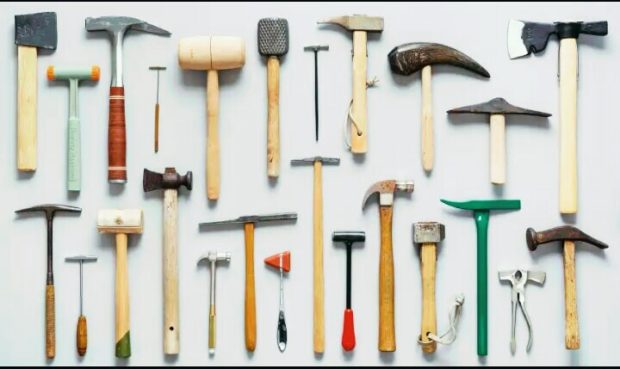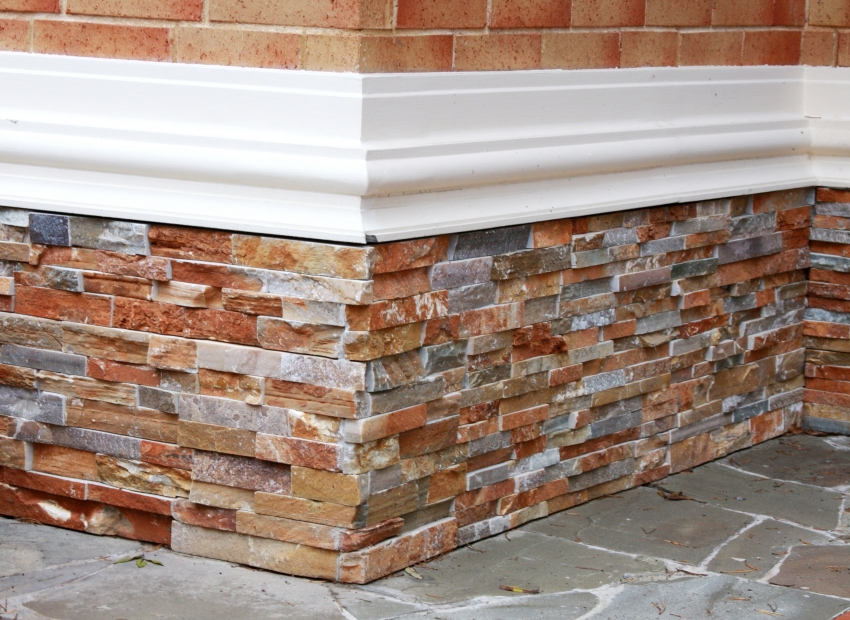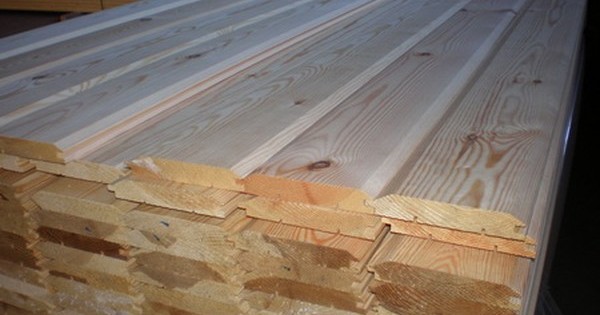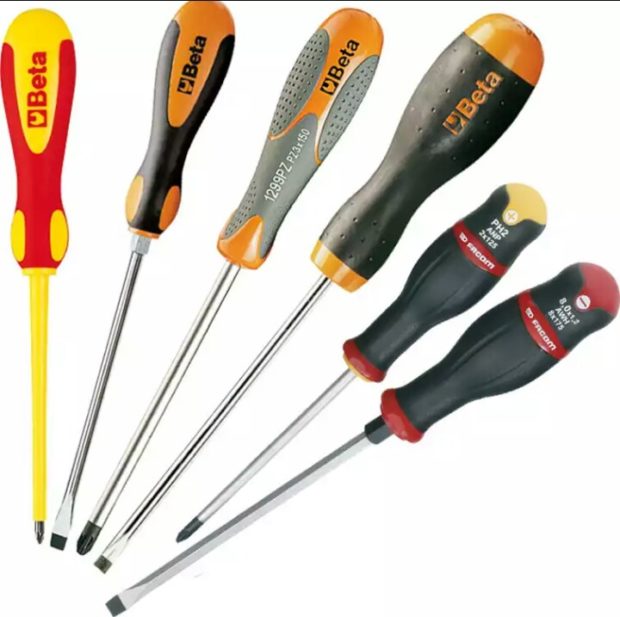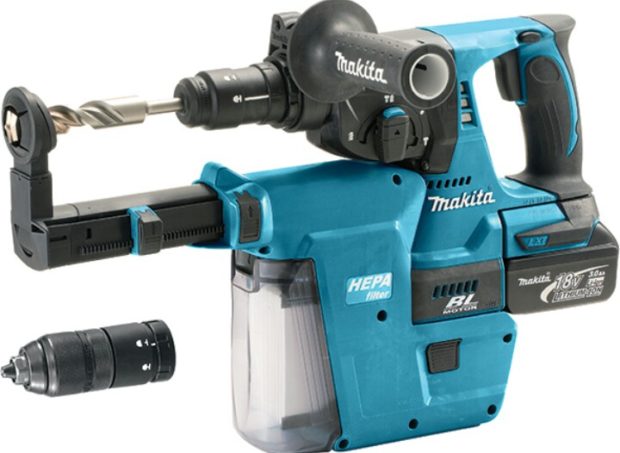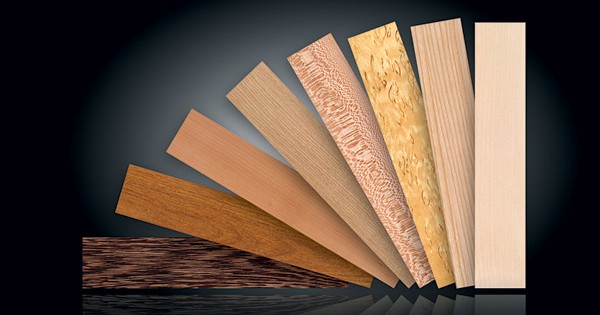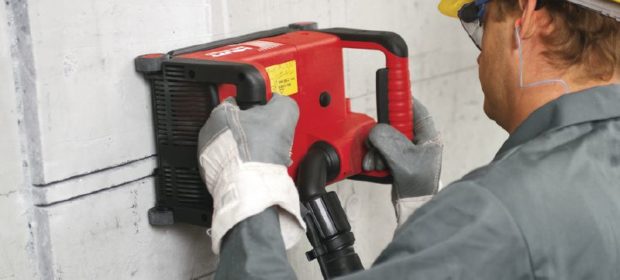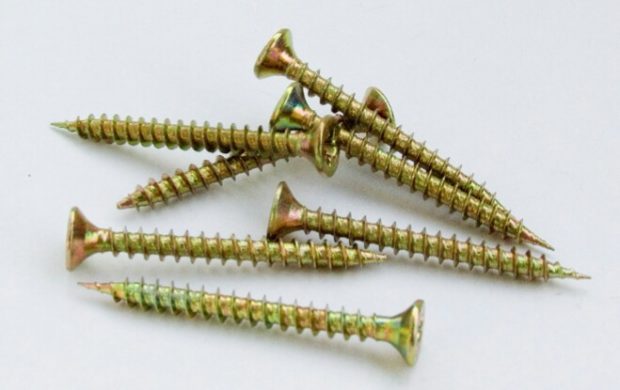8 tips for choosing an ax for all occasions
The ax is one of the most ancient tools of labor, versatility and simplicity served as a reason for implementation in almost all spheres of human activity. He is an indispensable assistant in the kitchen, on the construction site, in the garden and economic activities, as well as during recreation and trips to nature.
Structural elements
The ax consists of a head and a handle called an ax. Depending on the purpose, the form may vary slightly to adapt to specific jobs, but the configuration as a whole is unchanged.
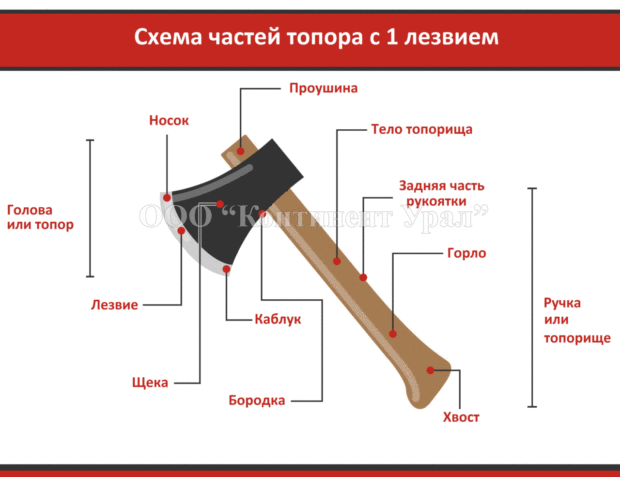
Upon closer examination, we can distinguish:
- eye - This is a hole serving to fix the ax;
- beard - serves for more reliable mating of parts by increasing the area of the support, distributes the load transmitted to the handle upon impact;
- toe and heel - the upper and lower corners of the blade, a smaller degree will help to perform fine work;
- blade - the ground part, usually 5-10 mm, the angle varies from 25 to 50 degrees, depends on the functionality of the product, the metal in this section is quenched;
- cheeks - side parts. The longer they are, the deeper the tool will be able to penetrate into the processed raw materials with a single impact;
- Tail - necessary to prevent slipping of the tool in the process, serves as a kind of emphasis;
- Butt - serves to strike, can be used instead of a hammer for inaccurate and few work.
Head material selection
When buying an ax, carefully inspect its head, because during operation this part will experience the greatest loads, it should be free of cracks and chips, check the geometry of the product, it may be broken during manufacture, which significantly complicate the operation, reduce the accuracy of striking. A good product is made of tool carbon or alloy steel. For domestic manufacturers, Soviet metal markings are still relevant: U7A, U8, U8A, U8GA, 65G - the most suitable. If for some reason it is not possible to find out the brand from the seller or there is no description, you can check the quality of steel using the "old fashioned method", for this you need to hit the head of the ax, it’s better to use some small metal object and carefully listen to the resulting sound, it should be voiced, and a dull sound is a sign of poor quality.
significantly complicate the operation, reduce the accuracy of striking. A good product is made of tool carbon or alloy steel. For domestic manufacturers, Soviet metal markings are still relevant: U7A, U8, U8A, U8GA, 65G - the most suitable. If for some reason it is not possible to find out the brand from the seller or there is no description, you can check the quality of steel using the "old fashioned method", for this you need to hit the head of the ax, it’s better to use some small metal object and carefully listen to the resulting sound, it should be voiced, and a dull sound is a sign of poor quality.
Hatchet material selection
 When choosing a tool handle, you must first determine the requirements for yourself, having studied all the advantages and disadvantages. Convenience at work and the service life of the tool depend on this.
When choosing a tool handle, you must first determine the requirements for yourself, having studied all the advantages and disadvantages. Convenience at work and the service life of the tool depend on this.
At the moment, there are axes for sale made of wood, metal, plastic and fiberglass (fiberglass and fiberglass in use).
From time immemorial for this part of the ax was used wood, a relatively cheap and widespread material, remarkably absorbing shock at work. A guarantee of durability will be high resistance to shock and compression, the part in the eye is the most vulnerable, the main loads fall on it, you need to pay attention to the rigid fixation in this tool assembly. The harder the tree species, the better, the oak, ash, jatoba and hickore will be reliable, the birch trees will be slightly worse, but you should not choose conifers.An unfinished handle is unacceptable, this defect will lead to premature failure at the junction, and the formation of dry cracks is also likely during the drying process.
- To the benefits the choice of wood handles can indicate accessibility, sufficient strength and durability, maintainability.
- By cons, since this is a natural material, - uneven properties due to the presence of knots, instability to variable humidity, as well as susceptibility to decay during the growth of fungi and mold. To keep the handle as long as possible, manufacturers often cover it protective equipment - antiseptics, alkyd varnishes and enamels, but there are also not covered with axes, in this case, to save the tool, it is worth processing them yourself.
All-metal axes or with a metal handle, have rubberized or plastic pads for ease of grip and to prevent slipping, have a large margin of safety and weight, but do not completely extinguish the impact on impact. Maintainability is doubtful, because when welding, the seam weakens the structure and increases the damage safety of an already unsafe tool, in addition, such products quickly lose their appearance, the metal becomes corroded, and the linings become unusable and can “fly off” during operation.
Plastic - quite a budget material, beautiful and comfortable, has a wide range of shapes, well dampens the shock wave. Perhaps the biggest disadvantage is fragility, especially in freezing temperatures.
Fiberglass axes - the most successful option, combining all the advantages of the above materials, combining high strength, lightness, convenience and aesthetic qualities and lack flaws in the form of corrosion, like metal, or rot, like wood. The only drawback is the rather high cost.
How to choose a good tourist ax
Travel axes are appreciated for their lightness, compactness and multifunctionality (a combination of several tools in one product). You should not chase a huge set - this will complicate the work, significantly reduce your comfort during operation. It will be optimal to choose well-fitted two, three tools, for example, an hatchet and a knife, or an hatchet and a saw, this will reduce the weight of your luggage, add comfort. You should not save with such a purchase, because in nature you will not have the opportunity to easily repair or quickly acquire a new one in the event of a breakdown. Choose among manufacturers specializing in travel products.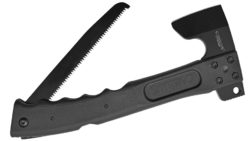
The length of the handle should not exceed 30 centimeters, the optimal weight is from 600 to 800 g (too light will not provide the necessary impact force, heavy ones will add excess weight), this combination of characteristics will allow you to complete tasks quickly and easily. An additional option in the form of a convenient cover, which can be attached if necessary to the belt, will not be superfluous.
How to choose a good carpentry ax
When choosing a carpentry ax, four main characteristics should be considered:
- Ax weight, is an individual parameter, ranging from 0.9 kg to 1.7 kg. The professional carpenter in the arsenal has several tools of different weights that are used for certain tasks. The strength and accuracy of the impact depends on the weight. A heavier ax will be better to chop, but in the process, the wizard will get tired faster. A lightweight ax makes it easier to strike more accurate, filigree punches. There is no complicated way to choose a product of suitable weight for yourself. To do this, lower the outstretched hand down and grab the handle of the ax as close to the end as possible, by moving the brush, try to raise it to a horizontal position: if you cannot do this, you should pick up a less weighty tool.

- Blade Rounding Radius from 27 to 33 centimeters. You can check it by drawing the indicated radii on a sheet of paper and compare by applying the ax to the drawn arc.The angle of the sock should be equal to or less than 90 degrees, this feature will allow you to extrude the spikes without an additional tool. The head should be of medium length.
- Grinding angle 30 °should be used for soft wood, 35 ° most Suitable for hard rocks. A sharper one will require frequent sharpening, too blunt - it is bad to enter the wood fibers and split the massif instead of cutting. It is more convenient to have several tools so as not to constantly change the angle of sharpening. You can estimate the number of degrees using a home-made template, for this, the necessary angles are drawn on a sheet of metal using a protractor and cut out with scissors, measured by comparing the template with the blade.
- Ax length (essentially a lever). The impact force depends on it, it is determined directly under the working person, it is approximately equal to the distance from the elbow bend of the arm to the fingertips of the open palm (for people of average height it will be about 44-50 centimeters).
The construction (carpentry) ax is the most versatile and is used not only for the manufacture of structures, but also in the garden in the country, often they chop wood, hammer nails and others, if you need a hatchet for a bit of everything, you should opt for this modification.
How to choose a good cleaver
A cleaver is a highly specialized tool used for harvesting firewood. If you do not need them on an ongoing basis, in large quantities, you should refrain from such a purchase.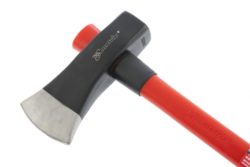
There are:
- "Mini-splitters" are used for small logs, it weighs about 1.5 kg and has a relatively small hatchet up to 60 cm;
- a large cleaver has a long handle over 70 cm, and weight can reach 5 kg, used for massive logs;
- “Ironing” - a classic Soviet product that has established itself as simple and convenient, is better suited for splitting dry wood;
- a sledgehammer is distinguished by the presence of a hammer, used for driving wedges, heavy is more suitable for professional loggers as additional;
- wedge-shaped cleaver with a rounded blade, more suitable for raw and viscous material;
- the eared one is distinguished by a thin blade resembling an ordinary ax, but has massive plots with large expansion areas. According to buyers, it is more suitable for a well-dried tree, it often gets stuck in raw chocks.
The sharpening angle of the cleaver should be from 40 to 50 degrees. Choosing a handle, it should be noted that you will work mainly with two hands, its length is from 50 cm and more, while the grip should be comfortable, the tool should not slip. The head of the cleavers is relatively small relative to the product, which often leads to the hitting of the handle on the chock, so pay attention to the protection of the ax. It is performed in the form of a lining, made of metal or impact-resistant plastic, located down from the head about 10 cm long.
How to choose a good meat cutting ax
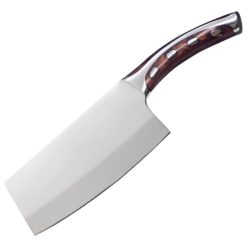 Hatchets for cutting meat are widely in demand, they are used by both housewives in the kitchen and professional butchers, this has led to a wide range with different shapes and weights. It easily copes with cutting even the thickest bones, and the rounded shape of the blade will help to freely cut the meat fibers. It is necessary to select a tool depending on the goals pursued, only in this case the operation will be easy and convenient.
Hatchets for cutting meat are widely in demand, they are used by both housewives in the kitchen and professional butchers, this has led to a wide range with different shapes and weights. It easily copes with cutting even the thickest bones, and the rounded shape of the blade will help to freely cut the meat fibers. It is necessary to select a tool depending on the goals pursued, only in this case the operation will be easy and convenient.
The classic ax for cutting carcasses consists of a hatchet and a head noticeably larger, it weighs from 2 to 5 kg. The angle of sharpening of the blade is from 25 to 30 degrees: if it is much smaller, the blade quickly blunts, chips and crests appear, a large angle will crush the bone when cutting carcasses, the resulting bone chips will worsen the quality of meat products.
The food sector is quite demanding on sanitation, so when choosing, special attention should be paid to the hygiene of materials, the absence of cracks and pores.Materials should be easy to wash, resistant to acidic and alkaline environments, detergents. It is better to opt for alloyed and stainless steels, without engraved inscriptions and stamps - these areas during operation will create additional problems when washing, contribute to the development of pathogenic microorganisms. The handle should not be too long, designed to capture mainly one hand.
When working with products, an extreme environment for metals is created, so the working part will often require manual sharpening. When buying an ax, you should immediately take care of the availability of a tool for sharpening the blade.
For work in the kitchen, it is more advisable to choose meat cleats: they are better suited for the final stages of cutting. Their weight usually does not exceed 1.5 kg, the length of the blade varies from 13.5 to 18 cm. There may be a hole in the canvas, which serves to reduce weight and ease of storage. The range of these products is so wide that every chef will be able to choose the most suitable shape and size. When choosing, it is worthwhile to pay attention to steel, it should be of high quality, there should be no signs of corrosion, scratches and caverns on the blade. The handle of the kitchen tool must be well mounted and strengthened.
Ax sharpening
 With the advent of such an indispensable tool as an ax in your household, a new task arises - maintaining it in working condition, because no matter how carefully you treat your tool, it wears out and its working part, the blade, is most exposed to wear. It must be constantly corrected or sharpened, and sometimes change the angle of sharpening. You can sharpen an ax manually, or using a power tool.
With the advent of such an indispensable tool as an ax in your household, a new task arises - maintaining it in working condition, because no matter how carefully you treat your tool, it wears out and its working part, the blade, is most exposed to wear. It must be constantly corrected or sharpened, and sometimes change the angle of sharpening. You can sharpen an ax manually, or using a power tool.
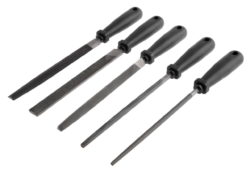 For manual sharpening file is used, grinding bars, you can make a homemade device from sand paper and a wooden stand, for mechanized use a sharpener or angular section machine. Before starting work, you must determine the required angle, select it depending on the purpose, make a stencil for inspection. In the process, you should not make excessive efforts so as not to spoil the abrasive and the tool. When working on an electric tool, it is better to use the clamps so as not to spoil the ax. Do not overheat the metal of the head, from this its properties may deteriorate.
For manual sharpening file is used, grinding bars, you can make a homemade device from sand paper and a wooden stand, for mechanized use a sharpener or angular section machine. Before starting work, you must determine the required angle, select it depending on the purpose, make a stencil for inspection. In the process, you should not make excessive efforts so as not to spoil the abrasive and the tool. When working on an electric tool, it is better to use the clamps so as not to spoil the ax. Do not overheat the metal of the head, from this its properties may deteriorate.


